Aircraft Maintenance Carrier

Battle Honours
ARMADA 1588
CADIZ 1596
PORTO FARINA 1655
SANTA CRUZ 1657
LOWESTOFT 1665
ORFORDNESS 1666
SOLEBAY 1672
SCHOONEVELD 1673
TEXEL 1673
‘Vestale’ 1761
'Tribune' 1796
BASQUE ROADS 1809
SALERNO 1943
OKINAWA 1945
KOREA 1950-53
Specifications
Builder: Vickers Armstrong, (Barrow-in-Furness, United Kingdom
Displacement: 18,330 tons
Length: 695 ft
Beam: 80 ft 4 int
Draught: 23 ft
Speed: 25 Knots
Crew complement: 1,076
Squadrons operated
800
Hurricane IIc
March - April 43
817
November 44 - January 45
Barracuda II
809
Seafire IIcs/L.IIcs
August - October 43
818
Swordfish
March 43 - August 44
824
Swordfish II
March - May 43
847 ()Det 8)
January 1944
Barracuda II
887
Seafire IIcs/L.IIcs
April - October 43
897
Seafire IIcs/L.IIcs
August - October 43
Commanding Officers
First Commission
Captain Q. D. Graham, CBE, DSO, RN 14 Jan 1943
Captain H. S. Murray-Smith 7 Nov 1944
Captain G. R. Deverell 14 Jan 1946
In Reserve
Lt. Cdr J. D. H. Manly
Cdr G. T. McInnes
Lieutenant W. A. Woolley
Second Commission
Captain H. S. Hopkins OBE 1949 - N0ov 1950
Captain J. Y. Thomson Nov 1950 - May 1951
Captain R. R. S. Pennefather May 1951 - August 1952
Commander P. F. Mansty August 1952
Related items
“The Forgotten Cruise” An account of HMS TRIUMPH and the 13th Carrier Air Group, the first Royal Navy Carrier Force in the Korean War, June- September 1950
Reminiscences
Gallery
H.M.S. UNICORN
Read aloud

Recommissioned for service in the Far East 1949
In 1948 UNICORN underwent a refit to prepare her for use as a combined Maintenance and Replenishment aircraft carrier but still be able to function as a Light Fleet Carrier. In the summer of 1949 UNICORN was recommissioned for service with the Far East Fleet, Captain H. S. Hopkins OBE in command.
The Far East Fleet was being reinforced in light of Communist insurgency and the treat to British interests in the region; by early 1950 the Fleet would comprise of the 5th Cruiser Squadron - BELFAST, JAMAICA, KENYA; 1st Aircraft Carrier Squadron - TRIUMPH, UNICORN; 8th Destroyer Flotilla –CHARITY, COCKADE, COMUS, CONCORD, CONSORT, COSSACK, CONSTANCE; 3rd Frigate Flotilla –ALACRITY, ALERT, BLACK SWAN, HART; 4th Frigate Flotilla – CARDIGAN BAY, MORECOMBE BAY, MOUNTS BAY, ST. BRIDE’S BAY, WHITESAND BAY. Also, the Hospital Ship MAINE.
The RN was also reopening its Naval Air Station at Sembawang, Singapore to to support the Light Fleet carrier TRIUMPH which was to begin strike operations against Malayan Insurgents in October. RNAS Sembawang had limited shore support facilities and no Air Repair Yard existed in the Far East command; UNICORN was to provide to provide aviation support for TRIUMPH’s 13th Carrier Air Group (12 Seafire FR.47s of 800 NAS and 12 Firefly FR.1s of 827 NAS) during operations off the Malayan coast.
UNICORN began embarking her ferry load from the AHU at
RNAS Abbotsinch while alongside in Glasgow on September 17th, this included 32 Firefly, 27 Seafire and 2 Sea Otter aircraft plus additional stores and equipment for both
RNAS Sembawang and HMS TRIUMPH. A further 4 Fireflies and 6 Sea Fury were loaded for delivery to AHU Hal Far, Malta. She sailed from the UK on October 1st. While on passage through the Suez Canal on October 6th she ran aground and blocked north bound Suez Canal traffic for 14 Hours before being refloated.
Supporting RNAS Sembawang and HMS TRIUMPH
UNICORN arrived at Singapore on October 26th and disembarked an advance party to Sembawang to establish a small Aircraft Holding Unit and test flight to ease pressure in UNICORN’s hangar. Thirty aircraft, a mix of Seafires and Fireflies, some embalmed for storage, where disembarked to the quayside in the naval dockyard, some 5 miles away, and transported to the airfield by road on the 29th. The party of maintenance personnel was under the charge of Lieutenant R. Hallett, the Test Pilot. Any aircraft repaired aboard UNICORN operating alongside in No. 8 berth in the Naval Dockyard had to be towed by road to Sembawang for test flights and the AHU was also tasked with addressing any issues the flight may have turned up.
RNAS Sembawang had been transferred to the RAF on loan on January 16th 1948 to relieve pressure on other RAAF stations on the Island of Singapore. The RAF presence was reduced to care and maintenance status on September 15th 1949 and the station was being prepared for return to RN control. TRIUMPH’s 13th Carrier Air Group had disembarked to Sembawang on October 3rd. They were to make the Royal Navy’s first air strikes against Malayan Insurgents during the month. They re-embarked in TRIUMPH on November 1st.
UNICORN sailed for Hong Kong on November 21st escorted by the destroyer COSSACK; she was one of six ships from Singapore sent to the Colony to help protect British merchantmen outside Chinese territorial waters which had been the targets Nationalist shelling and bombing. This was a short stay however, she arrived back in Singapore on December 9th in company with TRIUMPH and the destroyer CONSTANCE. At the end of November UNICORN provided a deck for pilots form TRIUMPH’s 800 and 827 squadrons for a DLT session on the 29th; one aircraft from each squadron suffered a deck crash, Seafire VP450 caught no. 9 wire but the tail unit pulled out and the rest of the aircraft continued into the barrier, and Firefly PP530 drifted to port causing the starboard undercarriage to collapse. TRIUMPH’s squadrons disembarked to Sembawang on December 8th.
UNICORN now underwent a short dockyard maintenance period, remerging in mid-January 1951. She arrived in Singapore Roads on January 14th and was open to the public over the weekend between 14:00 and 18:00; she out to sea in the a.m. for DLT sessions for aircraft flying out from
Sembawang. On the 16th Lt. I. J. Davis in Firefly PP535 had to make a blind emergency landing after his cockpit filled with smoke. The aircraft caught the last wire but continued up the deck, its undercarriage being torn off by the crash barrier, it then slid up the deck on its belly and went over the side of the bow into the sea. He was safely rescued by the plane guard destroyer HMS CHARITY.
A re-evaluation of UNICORN’s role
The airfield at Sembawang was returned to RN control on January 12th 1950 and re-commissioned as HMS SIMBANG on the 29th, Commander C. E. Eckersley-Maslin in command. The aircraft of TRIUMPH’s squadrons made further strikes against targets near Gemas in Negri before re-embarking on February 4th. By this time, it had become apparent that UNICORN was unsuitable for operation as a static aircraft repair factory; air maintenance ratings tended to be used for ship's duties reducing manpower for the repair programme; the flight deck was not always available, or suitable for running engines, the heat in the hangars coupled with poor ventilation was not conducive to aircraft maintenance.
The need to conduct test flights ashore also tied up additional personnel at Sembawang since it was not known what defects would be thrown up and therefore what tradesmen would be needed to rectify them, the tendency was to play safe and have a large number of maintenance personnel at the airfield when they could have been used in the ship. Productivity suffered as a result, about a third of the work that could have been achieved ashore in an airy hangar and with no interruptions. These issues identified in UNICORN resulted in the decision being made to forgo afloat support and to establish an Air Repair Yard at Sembawang in June 1950. The entire Air Engineering Department (AED) was to be landed to Sembawang and the ship would return to the UK and pay off.
UNICORN was scheduled to sail for a cruise to Japan as part of the Far East Flee during April and May and she sailed in company with TRIUMPH, arriving at Hong Kong on. April 8th. Departing Hong Kong for Japan on April 11th UNICORN to visit Iwakuni and TRIUMPH to Yokohama both arriving on the 15th. From Iwakuni UNICORN went to KURE, where on May 12th she was alongside in Kure harbour dressed overall to celebrate the 13th anniversary of the coronation of King George Vi. UNICORN arrived back at Singapore on June 20th 1950.
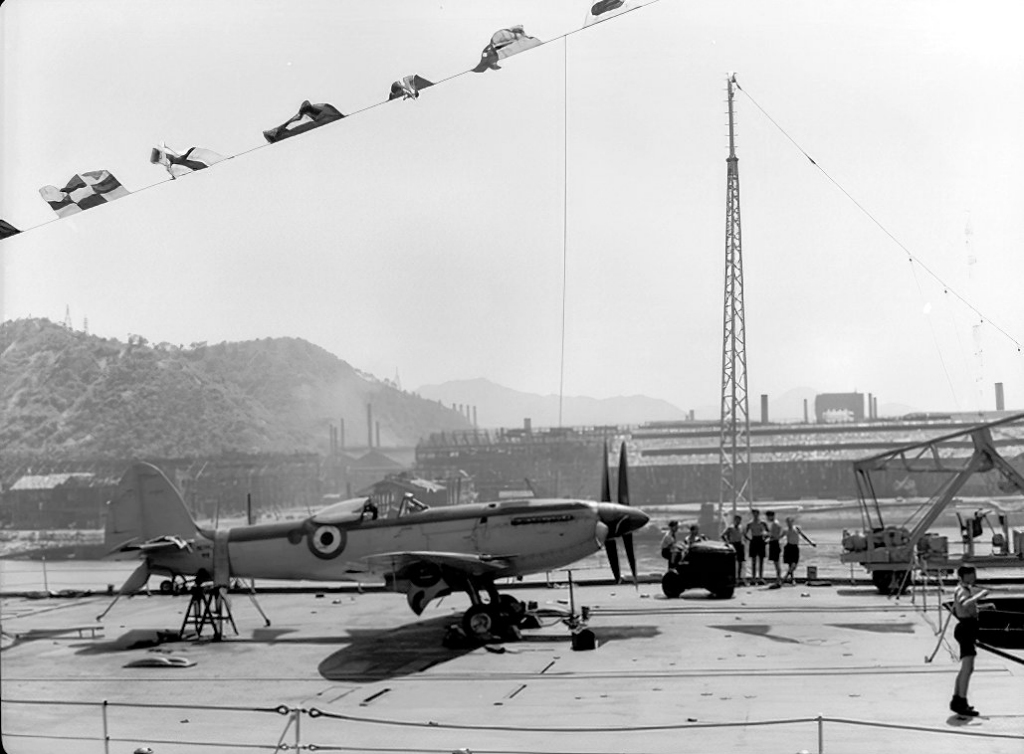
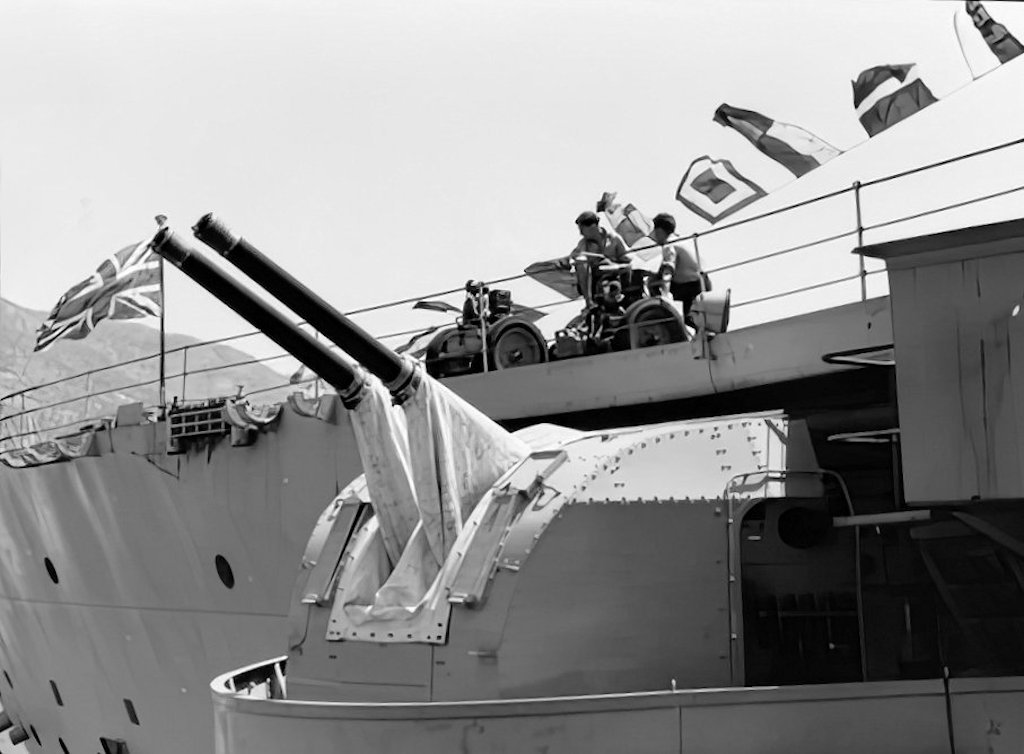
UNICORN alongside at Kure. Japan May 12th 1950, the ship is dressed
with flags to mark the 13th anniversary of the reign of King George VI. Left: A Seafire F.47 has its tail jacked up to level the aircraft for maintenance. Right: view of the starboard aft twin 4” gun turret, UNICORN had one such turret on each quarter. Photographer: Hobson, Phillip Oliver. Images source Australian War Memorial.
The Korean War
Work now commenced to unload her in preparation for entering the Naval Dockyard for a re-fit before departing for the UK in mid-August. However, her re-fit was curtailed when North Korea invaded the South on Sunday, June 25th; she was now required to remain on station. Her return home was cancelled and stores, ammunition and aircraft were hastily re-embarked when she was ordered to sail at short notice to ferry reserve aircraft and stores for TRIUMPH. As a result of this relocation of resources Sembawang’s workshops were scaled to that of a full Air Repair Yard with a throughput of 20 aircraft per month, the AHU now had storage for 80 aircraft and test flying. The station could also support 1 disembarked Carrier Air Group.
Having decided to leave the majority of her AED ashore UNICORN would be used primarily as a ferry/replenishment carrier transporting aircraft and supplies to the Royal Navy and Commonwealth aircraft carriers operating in Korean waters. After embarking aircraft and stores from Sembawang she sailed on July 11th for Japan, and rendezvoused with TRIUMPH at Sasebo on July 20th. Here she transferred 7 Seafires and 5 Fireflies to TRIUMPH as squadron replacements. On the 24th she sailed for the British Commonwealth Air Group (BCAG) base at Iwakuni to collect the unserviceable aircraft left by TRIUMPH and to deliver spares.
She next sailed for her first-round trip voyage, Sasebo to Singapore, via Hong Kong to exchange aircraft and stores; on average these trips would take six weeks. She arrived in Hong Kong on July 30th and disembarked about 50 Chinese civilians who had been employed on the British warships off Korea as laundrymen, cobblers and tailors during peacetime. She arrived back in Singapore on August 5th to deliver unserviceable airframes and loaded new reserves and stores.
She arrived at Hong Kong on August 17th escorted by the destroyer COSSACK. Here she embarked troops of the Middlesex Regiment, while the Cruiser CEYLON embarked men of the Argyle and Sutherland Highlanders for passage to Pusan; these were part of the 1,500 strong ground force being deployed to Korea by Britain. The two ships arrived in (an unnamed) Korean port on August 29th and the troops were disembarked. UNICORN arrived back in Singapore from her trooping trip on September 8th and began a short refit in Sembawang Naval Dockyard one week later.
Part of an aviation support organisation spanning 12,000-miles
The aviation support organization now in place spanned 12,000 miles from the UK to Singapore and on to Japan. Consignments of aircraft were ferried out from the AHU at RNAMY Abbotsinch in ferry carriers to the AHU at Sembawang. Once flight ready these joined the Operational Flight Pool from where they were issued to UNICORN or one of the Light Fleet Carriers directly on visiting Singapore. The first such ferry load was embarked in HMCS WARRIOR on August 22nd 1950 when 16 Firefly and 16 Sea Fury were despatched from AHU Abbotsinch; after unloading on September 15th a reciprocal consignment was loaded for return to the UK.
On September 12th 1950 the first Sea Fury squadron had arrived in theatre; 807 squadron disembarked from THESEUS with 12 Sea Fury FB.11s, the first of their type to visit Sembawang. The Sea Fury was to replace the Seafire in front-line service from now on and a consignment delivered by WARRIOR during the month was to establish a stock at the AHU Sembawang. 807 re-embarked a week later on the 20th when the carrier sailed to relieve TRIUMPH on station. With the departure of 807 squadron Sembawang settled into its role as a repair yard and aircraft holding unit.
UNICORN completed her refit on October 27th and after loading stores and replacement Sea Fury and Fireflies she sailed again for Sasebo to support THESEUS, arriving on November 1st. After unloading she sailed to return to Singapore experiencing the edge of typhoon ‘Clara’ on the 10th, she arrived back at Sembawang on the 14th. Captain J. Y. Thomson relieved Captain Hopkins as commanding officer during November.
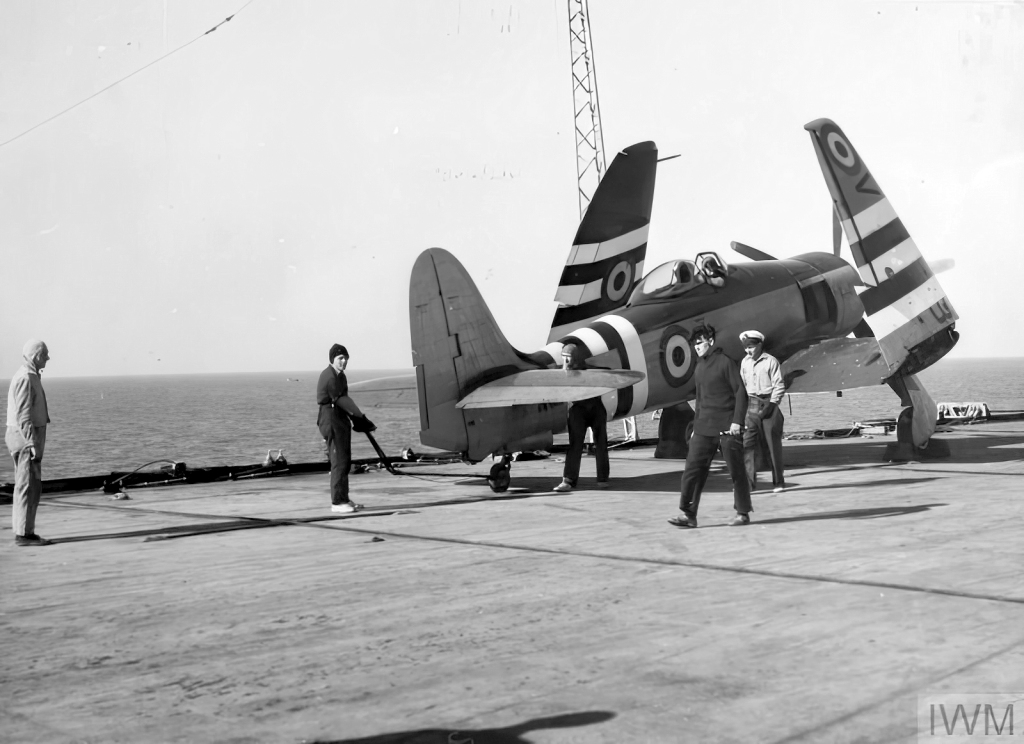
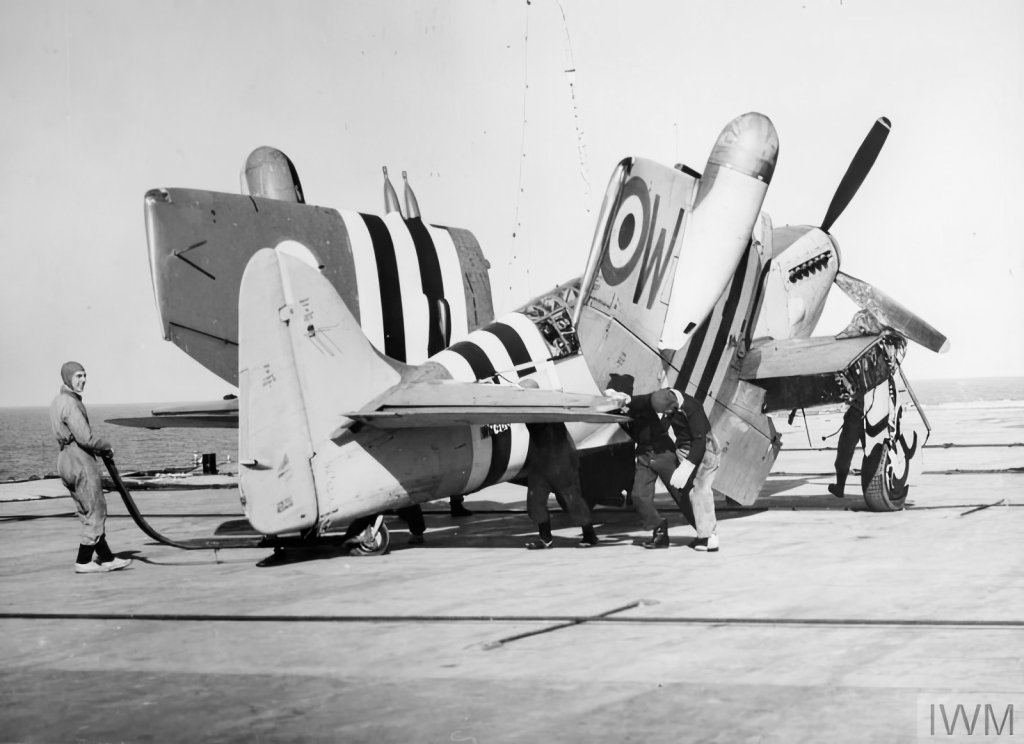
January 1951 reserve aircraft on UNICORN. Left: Manually ranging a Seafury on the flight deck © IWM A 31806. Right: inspecting a Firefly as part of pre-flight checks © IWM A 31811.
Supporting HMS THESEUS
UNICORN sailed north again on December 2nd, embarking 400 passengers at Hong Kong, she arrived at Sasebo on the 10th. After disembarking her passengers, she sailed the same to rendezvous with THESEUS in the operational area off the west coast of Korea. She carried 5 Sea Furies and 1 Firefly for delivery, pilots were transferred by escort destroyers who then flew them over to THESEUS. Stores were transferred to other destroyers by light jackstay before she withdrew, arriving back at Sasebo on the 12th. The following day she sailed for Iwakuni where a number of newly arrived pilots for THESEUS would undertake Aerodrome Donny Deck Landings (ADDLs) following by deck landing qualification on UNICORN. This pilot training lasted from the 14th to the 27th when UNICORN sailed for Kure. While three she provided working parties to assist THESEUS and her escorts celebrate a delayed Christmas upon their return from the operational area. She sailed from Kure on January 5th 1951 for Hong Kong embarking cargo on the 9th.
On her arrival off Singapore on January 15th 1951 four aircraft from RNAS Sembawang flew out to conduct Deck Landing Practice before the ship entered the dockyard and secured alongside No. berth. During this visit UNICORN’s AED complement was increased by transferring Lieutenant (E) R.B.L. Foster and about 25 ratings from the AHU at Sembawang. This was done in the hope that in addition to acting as a ferry carrier a limited amount of aircraft repair work would be done on board. Experience had shown that quite a number of aircraft discarded by THESEUS required 14 to 21 days work and it was uneconomical to send them on a 14-day passage to Singapore, have the work done at Sembawang and the aircraft then wait four to six weeks for UNICORN's next round trip.
Sailing again on January 25th she carried 400 troops for delivery to Hong Kong, replacements for the Middlesex Regiment and Argyle and Sutherland Highlanders. She arrived in the colony on the 27th and after disembarking passengers and exchanging cargo sailed for Sasebo on January 31st. She called at Sasebo on February 3rd and arrived at Kure on the 4th. She arrived back at Sasebo on the 16th, and at Singapore on March 5th.
On the 8th she embarked 5 Sea Fury from Sembawang together with 10 Gloucester Meteors for delivery to 77 Squadron RAAF at Iwakuni She arrived at Hong Kong on March 16th to embark stores and at Sasebo on the 21st and disembarked stores. She sailed for Iwakuni on the 22nd, arriving there on March 24th and transferred the Meteors ashore by barge, sailing on March 27th to return to Sasebo.During this visit the shortfall in ’in theatre’ support became apparent; two aircraft from THESEUS— a Firefly with one wing shot up and a Fury with half one propeller blade missing — were stranded ashore at USAF Suwon, an air base about 30 miles south of Seoul, Korea. THESEUS could not spare the manpower to carry out the necessary repairs so Lieutenant Robin Foster with a team of five ratings, a mainplane, a propeller and some tools were despatched from UNICORN, tasked with the job. They went from Kure to Iwakuni and then by midday they were embarked in a USAF C-110 with the spares and equipment and flown to Suwon. The repairs were done but only after resorting to the barter system to get any assistance from the USAF who knew nothing about them and had no orders concerning loaning a crane or even accommodation. The repair party re-joined UNICORN at Kure just before she sailed again for Sasebo. UNICORN was to spend the next three months operating at Sasebo, for part of this period she acted as an accommodation ship, and made a few short trips to Kure, Iwakuni, Yokosuka and Pusan. She entered drydock at Kure on April 8th, undocking on the 16th. She put to sea on the 17th to carry out a flying programme. HMS GLORY relieved THESEUS on station on April 24th. Captain R. R. S. Pennefather relieved Captain Thomson as commanding officer on May 5th 1951.

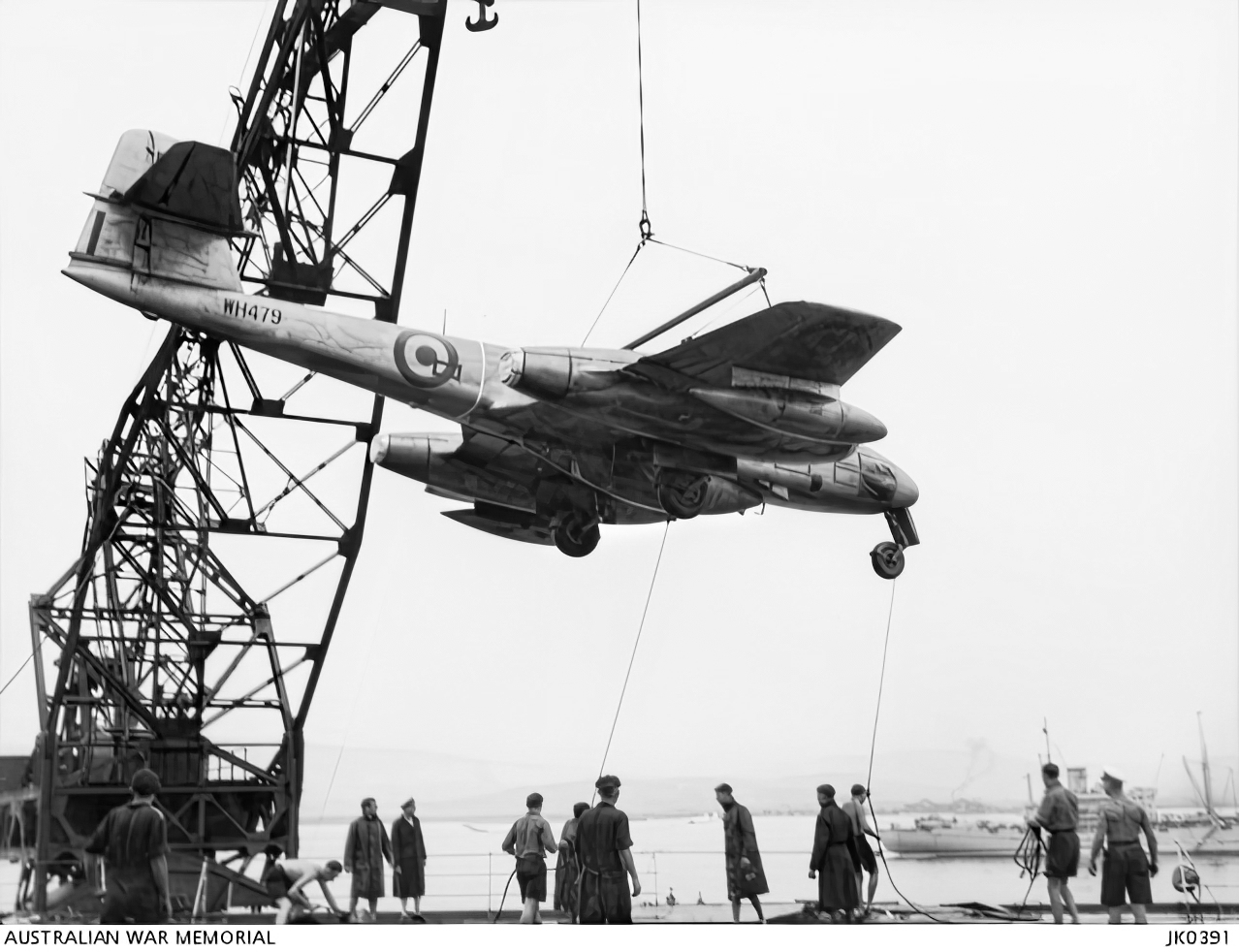
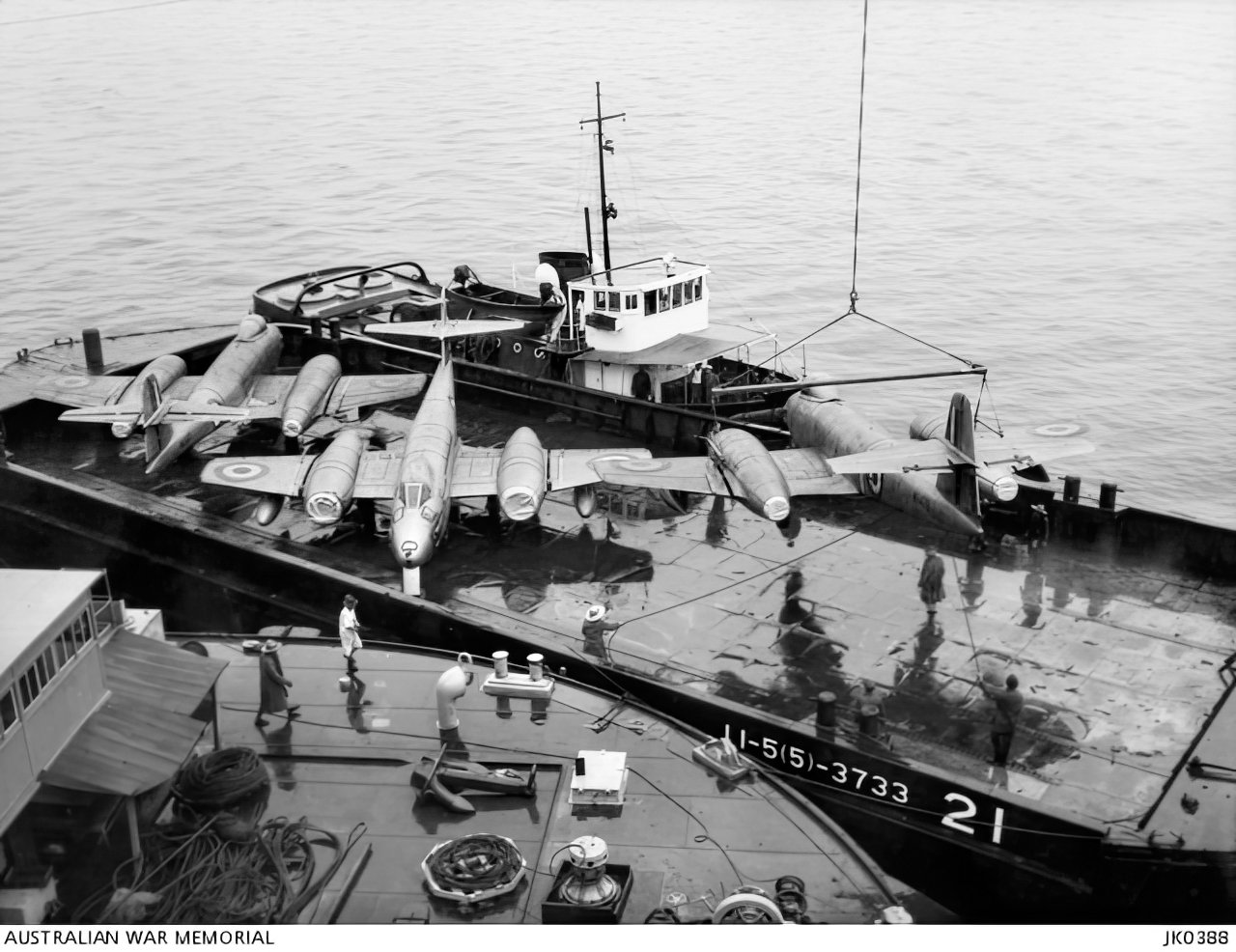
March 1951. Top: UNICORN with RAAF Meteors on deck for passage to Iwakuni. Bottom left: A Meteor is hoisted off by crane. Bottom Right: Meteors being lowered onto a lighter which will ferry them ashore at Iwakuni.
AHU and ARS established at Iwakuni and support for HMS GLORY, June 1951
After three months at Sasebo stocks of reserve aircraft were almost gone and UNICORN was due to sail for Singapore again in mind-June. Her 4-6 week turnaround meant there would be no replacement aircraft for issue to GORY, which had relieved THESEUS at the end of April 1951, which would require new aircraft several times during this period. The solution was to land UNICORN’s small AED party ashore to RAAF Iwakuni where a small Aircraft Holding Unit (AHU) and Aircraft Repair Section (ARS) were established under Lieutenant Foster to hold 24 aircraft for local issue before she sailed for Hong Kong on June 17th.
UNICORN arrived back in Singapore on June 27th. In addition to loading stores and reserve aircraft she embarked a further batch of RAAF aircraft, a mix of 10 Meteors and some Vampires, for delivery to Iwakuni. She sailed for Hong Kong on July 4th, arriving there on the 8th. Here the 6 Auster Mk 5s and personnel of No. 1903 (Independent) Air Observation Post Flight were embarked, also for Iwakuni. She sailed for Sasebo on the 10th arriving there on the 14th. She sailed for Iwakuni on the 16th to unload her cargo and passengers before continuing on to Kure to unload further stores and rendezvous with GLORY.
HMS GLORY returned to Kure on July 22nd for a rest period between patrols and several aircrews were sent to AHU at
Iwakuni to carry out test flights on recently repaired aircraft. It had been intended to exchange 6 aircraft before sailing for her sixth patrol but she was sailed at short notice to support the American carrier USS SICILY, she left Kure on the 24th; the aircrew left ashore at
Iwakuni flew out by helicopter later. UNICORN sailed for Hong Kong on the same day.

July 22nd 1951: GLORY
preparing to come alongside the pier at Kure where UNICORN waits
to transfer airframes and stores .
Return to Singapore for a short refit August - September 1951
UNICORN returned to Iwakuni, on route to Kure, on July 11th and this time eleven aircraft were exchanged before the ship proceeded to Kure harbour later the same day. After calling at Hong Kong 28-30th July she arrived back at Singapore on August 3rd 1951 to undergo a refit. She entered King George V dock on August 6th, her crew being accommodated ashore in HMS TERROR.
Her refit was completed on September 3rd and, after loading 5 Sea Fury & 1 Firefly she sailed for Hong Kong again on the 5th, and arrived Hong Kong on the 10th. Two Dragonfly helicopters had been embarked for delivery to the AHU at
Iwakuni , VZ964 and VZ965; Lt. Cdr J. W. Wickham was due to give a demonstration flight in Hong Kong harbour but his aircraft, VZ964 lost control transferring from hovering to full flight, it also lost rudder control, lost height, and crashed over the side. The aircraft was a write-off but the pilot was safely rescued. UNICORN sailed for Japan later that evening.
Briefly employed on Combat operations
She called at
Iwakuni on September 16th to deliver
the reaming Dragonfly along with 2 Sea Fury& 1 Firefly for the AHU. She sailed from Sasebo to recover two of GLORY’s aircraft salvaged from Paengyong-do on the 22nd before taking part in a combat operation North of the 38th parallel. Escorted by the destroyers COMUS and COSSACK
she conducted a series of bombardments using her Twin QF 4-inch Mk XVI guns against targets on Chopekki Point, out of sixteen salvos three were known to have found the target. She was the first Carrier to conduct a bombardment in the Korean War. On completion she returned to Sasebo.
Supporting HMAS SYDNEY
UNICORN next sailed for Kure on the 27th flying the flag of Admiral Scott—Moncrieff, arriving the following day. Here they joined GLORY and HMAS SYDNEY, her relief, and inter-ship sporting events were held before UNICORN sailed on October 1st to return to Sasebo; on this occasion the decision was taken to make passage via the Straits of Shimonoseki, the stretch of water separating Honshu and Kyushu, two of Japan's four main islands. UNICORN had successfully passed through before but could only undertake this passage if the tides were in her favour; stretching across the strait were several large power cables which she could pass under only of the tide was low due to her very tall mast head. On this occasion however heavy snow lay on the thick cables making them hang lower than usual and UNCORN,s radar mast, some 90 feet above the waterline snagged them and severed one. And disabling power on the island of Kyushu for several weeks. In future she was ordered to take the long route, some 300 miles more.
While at Kure UNICORN issued 3 replacement Sea Furies to SYDNEY before she put to sea on October 14th to avoid being in put when Typhoon ‘Ruth’ hit the Japanese coast. She weathered the storm on passage to Hong Kong arriving on the 18th. On the following day she was involved in a collision with a Chinses Junk which sank, all crew members were rescued safely. Waiting for her at Hong Kong were key members of her relief crew, those relieved left the ship at Singapore on November 1st.
At Singapore she embarked 5 Sea Fury & 5 Firefly from Sembawang and the usual stores, cargo and passengers before sailing for Japan on November 5th. She arrived at Kure on Sunday 11th moving to
Iwakuni to deliver 1 Firefly and 3 Sae Furies. A Remembrance Day service was held on the quarter deck. After exchanging aircraft, she sailed for Hong Kong via Sasebo wearing her paying off pennant.
Refit and new commission November 1951 – January 1952
On arrival at Singapore on November 22nd, she was to pay off her existing commission and embark a new commission crew during a refit period. The new commission draft had arrived on the Carrier HMS WARRIOR on the 19th and they went aboard on November 24th. The old commission crew sailed for the UK as passengers in WARRIOR when she sailed for the return leg of her aircraft ferry voyage. During her refit the crew were again billeted ashore at HMS TERROR. The ship entered drydock on December 9th, undocking on January 2nd 1952. The ship’s company re-embarked on the 16th and the refit was completed on the 20th.
On January 24th UNICORN embarked more Jet fighters for delivery, 5 Vampires for the RAF at Kai Tak, Hong Kong and another 8 Meteors for RAAF Iwakuni and 2 Sea Furies from AHU Sembawang before sailing on the 28th. She arrived at Hong Kong on February 2nd. She was joined by GLORY which was relieving SYDNEY on station; the two carriers had rendezvoused at sea to transfer aircraft before going their separate ways. After a short spell in Hong Kong, during which time inter-ship and inter-service sporting events were held, UNICORN sailed for Iwakuni on the 5th.
On the 6th news of the death of King George VI was announced and UNICORN fired a 57-gun salute, each round fired at one-minute intervals, to mark the length of his reign followed by a short service of remembrance. The following day a 21-gun salute was fired to mark the accession to the throne of Queen Elizabeth II.
UNICORN arrived at Iwakuni on the morning of Fenruary 9th in company with the American seaplane tenders USS SUISUN and USS FLOYDS BAY. That evening Lieutenant (E) P. J. Rugg went ashore to relieve Lieutenant (E) R. B. L. Foster as Officer in Charge of AHU Iwakuni; on February 11th she embarked 3 Sea Furies and 1 Firefly for eventual return to Sembawang before sailing for Sasebo.
At Sasebo on the 15th a small ceremony and 56 gun salute was conducted to make the funeral of the late King. The next day GLORY entered harbour, returning from her first patrol and requiring a replacement airframe, I Firefly was exchanged. UNICORN put to sea over the next few days to give deck landing practice to replacement pilots due to join GLORY. UNICORN sailed for Hong Kong gain on March 1st, arriving on the 4th. She next took part in the 4-day exercise operation VORTEX, operating 4 aircraft flown by pilots loaned from GLORY. She was not to return to Singapore on leaving Hong Kong; after embarking naval and army passengers she sailed to return to Sasebo on the 15th, arriving on the 18th. UNICORN next arrived at Iwakuni on April 1st to embark airframes damaged beyond the limited repair skills of the AHU; offloading 2 Sea Furies on the 2nd and embarking 3 Sea Furies on the 4th. Sailing for Kure on the 7th where she was joined by GLORY; four replacement aircraft were issued and 1 received.
She sailed for Singapore, via Hong Kong, again on April 14th, arriving on the 18th. Before sailing for Singapore she embarked 2 De Havilland Hornets from RAF Kai Tak for passage to RAF Selector. She sailed for Singapore on the 22nd, arriving there 3 days later. On April 28th she offloaded 2 Sea Furies for the AHU Sembawang before embarking vehicles, armaments and stores together with 4 Vampire Jets for RAF Kai Tak. She sailed on May 6th, arriving at Hong Kong on the 10th. She arrived at Kure on the 15th; after a brief call at Iwakuni she finally arrived at Sasebo on May 21st to meet with OCEAN which had relieved GLORY as the Commonwealth carrier on station. Eight days later she sailed for Singapore, via Hong Kong, arriving on June 11th.
UNICORN embarked 8 Sea Fury & 2 Firefly from AHU Sembawang and was turned around and ready for the return leg by June 20th, having embargoed stores and passengers for the trip north. After calling at Hong Kong she arrived back at Sasebo on June 29th to rendezvous with OCEAN. Three Fireflies and a consignment of stores were issued to OCEAN on the 30th.
A second period of combat operations
On July 3rd UNICORN sailed with OCEAN on her return to her patrol area, acting as a ‘spar deck’ at ten minutes readiness to receive aircraft. On July 4th 54 landings were made by a pair of Sea Furies , The following morning she received on of OCEAN’s Fireflies, part of the first strike package of the day which made an emergency landing after developing a fuel leak; a replacement aircraft was issues and the crew were back on OCEAN by 07:30. UNICORN provided CAP for four spells during the day. Her catapult was out of action so the catapult officer and his team were sent across to OCEAN to gain experience of launching armed aircraft at max load. On the 6th UNICORN rendezvoused with BELFAST off Paengyong do to embark Admiral Sir Guy Russell (Cr-in-C Far East Fleet) and some of his staff for passage back to Sasebo, arriving there on the morning of the 7th. She sailed for Kure the following day, calling at AHU Iwakuni on the 9th to deliver 1 Firefly & 7 Sea Fury and embarking 1 Firefly & 3 Sea Fury before arriving at Kure on July 10th.
She then returned to Kure to embark bombs for delivery to Sasebo where she arrived on the 16th to unload. She sailed for Hong Kong on the 21st where she was to embark a variety of stores for Singapore including 5 cars and a prefabricated crane which was loaded onto the flight deck in sections by using the ship’s crane. She sailed again on July 27th and arrived at Singapore on the morning of the 31st. The Light Fleet Carrier VENGEANCE was waiting for her and 4 Sea Fury for return to the UK were transferred to her in the forenoon. UNICORN then proceeded to secure alongside at her usual berth in the Dockyard where the crane was off loaded and aircraft for Sembawang were disembarked. By August 9th loading of aircraft and stores for Japan was nearly complete; she was to ferry 18 RAAF Meteors on this trip and her flight deck was packed with airframes. She sailed for Kure on August 13th. The Meteors were disembarked by lighter to Iwakuni on the 20th.
A third period of combat operations
UNICORN prepared to join OCEAN for her third spell of duty in the operational area. It was found that having her as a spare deck and a CAP carrier considerably sped up turnaround times for strike aircraft on OCEAN; by providing the CAP aircraft OCEAN could focus on ranging and launching strike aircraft, and the ‘spare deck’ meant no hurried repotting of aircraft to clear the deck for an emergency landing- a process that could cause a delay to operations of as much as 30 minutes.
UNICORN joined OCEAN in the operational area on September 1st and was responsible for CAPs using Sea Furies pilots from 802 squadron loaned by OCEAN. Both carriers arrived at Sasebo at 17:00 on the 5th. After replenishing stores UNICORN and OCEAN sailed for Iwakuni, arriving on the 10th. UNICORN arrived in Kure on the 15th to begin a 4 week self-maintenance period, leave was given to both watches. On October 6th a concert party headed by Ted Ray performed on the ship.

UNICORN (left) and OCEAN alongside at Kure, Japan c. September 6th 1952. The two carriers had just returned from the operational area where UNICORN had provided CAP sorties and a spare deck.
First Sea Lord visits the ship
On October 10th UNICORN became the temporary Flagship of the First Sea Lord, Admiral Sir Roderick McGrigor GCB, DSO for the duration of his vest to Japan. He was joined by Admiral Sir Guy Russell (Cr-in-C Far East Fleet) and Rear Admiral E. G. A. Clifford CB (Flag Officer 2IC Far East Fleet). The following day the Admiral McGrigor inspected the ships company before touring the hangars and workshops. A dinner was held that evening attended by General W. Bridgeford CB, CBE, MC Commanding Officer Commonwealth Forces, his chief of staff and the Captains of vessels in harbour. On the 13th UNICORN proceeded to Iwakuni where the Admiral made a tour of the Aircraft Holding Unit before the ship proceeded to Sasebo, arriving on the 15th. The Admiral departed on the 19th and UNICORN sailed for Hong Kong, arriving on October 23rd.
UNICORN sailed for Singapore on October 27th, arriving there on November 3rd. While at Singapore OCEAN called on her way home, having been relieved on station by GLORY. While alongside in the Dockyard UNICORN embarked 9 Sea Furies & 3 Fireflies from Sembawang. On the 14th UNICORN sailed for Sasebo, via Hong Kong, arriving on the 24th. At Sasebo Rear Admiral Clifford came aboard and hoisted his broad pennant, UNICORN sailed for Pussan on the 25th for a visit with the Chief of Staff of the Republic of Korea navy. On completion of the visit she sailed for KUR on the 29th arriving on the 30th. She moved to Iwakuni on December 3rd and delivered 9 Sea Furies & 3 Fireflies before sailing for Singapore, via Hong Kong, on the thriving on 15th.
Refit December 1952 – February 1953
UNICORN now entered the dockyard for her second refit period; after unloading her stores and ammunition the main part of her crew moving ashore to HMS TERROR, the air department to HMS SiIMABNG. A dockyard strike began on December 29th but was resolved by January 9th 1953. The work was completed by the end of February, her crew began reloading stores and ammunition on the 28th. On March 7th she embarked 12 Sea Furies & 5 Fireflies from Sembawang After a short post refit shake-down she arrived at Kure on March 28th.
Here she replenished GLORY before sailing for Iwakuni to exchange airframes on April 8th; she delivered 8 Sea Furies & 6 Fireflies and embarked 8 Sea Furies & 2 Fireflies for return to Singapore. She arrived back at her dockyard berth in Singapore on April 22nd 1953. And unloaded 7 Sea Furies to & 2 Fireflies to AHU Sembawang the following day.
Preparations now began for the upcoming Coronation celebration on June 2nd 1953; a ceremonial guard of sixty ratings was assembled and trained to take part in the celebration parade. Admiral Sir Charles Lambe, KCB, CVO (Cr-in-C Far East Fleet) embarked and the ship and made a number of visits to ports on the Malaysian coast, Port Dickinson, Port Swettenham, Penang and Malacca. On reaching Malacca on May 18th she was open to visitors 2 p.m. until 5.30 p.m. She returned to Singapore Dockyard on completion of the visit. Om May 30th UNICORN, and two fleet minesweepers, LIONESS and LYSANDER, moved to anchorages in Singapore Roads to take part m the Coronation celebrations. All three ships were open to the public for the afternoons of June 1st, 3rd, 5th & 6th.
She spent the five weeks alongside in her dockyard berth preparing to return to Japan, embarking 7 Sea Furies & 3 Fireflies that had been prepared for service by the ship’s air department and the AHU at Sembawang. She sailed for Japan on July 17th, she left Hong Kong on the 25th.
One day out from Hong Kong on passage to Kure UNICORN received a distress call from the SS INCAHKILDA which reported being under attack by Chinese nationalist gunboats east of Ockseu Island. UNICORN increased speed to 22 knots to intercept and the INCAHKILDA was sighted at 11:30 on the morning of the 27th. She had been boarded and was under escort by three gunboats, one leading 5 cable ahead and 2 following aster; After instructions to heave to given by both signal lamp and international signal flags were ignored UNICORN’s captain reduced speed and ordered four aircraft to be ranged on the flight deck to make her appear more menacing. With all weapons brought to bear he proceeded to manoeuvre his ship, at speed between the lead gunboat and their prey, UNICORN was then put hard to starboard and continued to swing at full rudder around the INCAHKILDA to pass behind her stern in front of the trailing gunboats. The lead gunboat then swung alongside and hastily retrieved their boarding party before make a hasty retreat. After making inquiries with her captain UNICORN resumed her passage to Kure. Later that day the armistice was signed bringing hostilities to an end. She arrived at Sasebo on July 29th and replenished OCEAN, issuing 2 Sea Fury & 1 Firefly and received one unserviceable Sea Fury.
On patrol with OCEAN
On July 30th UNICORN sailed from Kure for another trip to the operational area with OCEAN, this rime for an extended period; the two carriers would be at sea for 12 days before returning to Sasebo on August 12th. During this patrol she again operated 4 aircraft manned by pilots loaned from OCEAN embarked to conduct fighter interaction sorties and to put UNICORN through her paces.
On the 11th a serious deck crash occurred; Sea Fury WJ240 piloted by Lt D. G. Halliday, had landed on and taxied forward beyond the barriers which were then raised in preparation for the next aircraft. Landing seconds later Sea Fury, WH623 piloted by Lt-Cdr J. W. Ayres, bounced and he opened the throttle to gain lift, the aircraft cleared no. 1 barrier but its hook engaged No. 2 barrier then stalled onto the deck striking WJ240 as it careered across the deck and went over the side in flames. The impact caused Lt. Halliday to open the throttle wide and his aircraft began an anti-clockwise circle around the deck. The tail section sheared off and also vanished overboard. Lt. Halliday applied the brakes, it then skidded on its nose towards the deck edge to collide with the Jumbo crane and caught fire. Lt. Halliday survived but was badly injured, Lt-Cdr Ayre was rescued unhurt by the ship's helicopter.
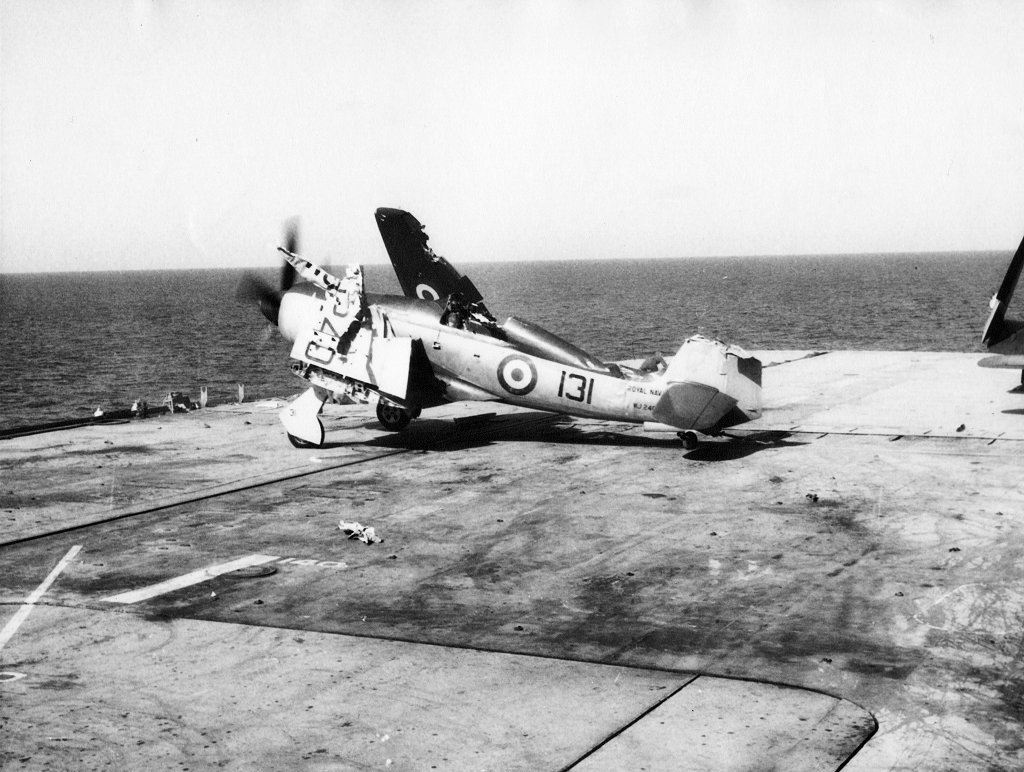
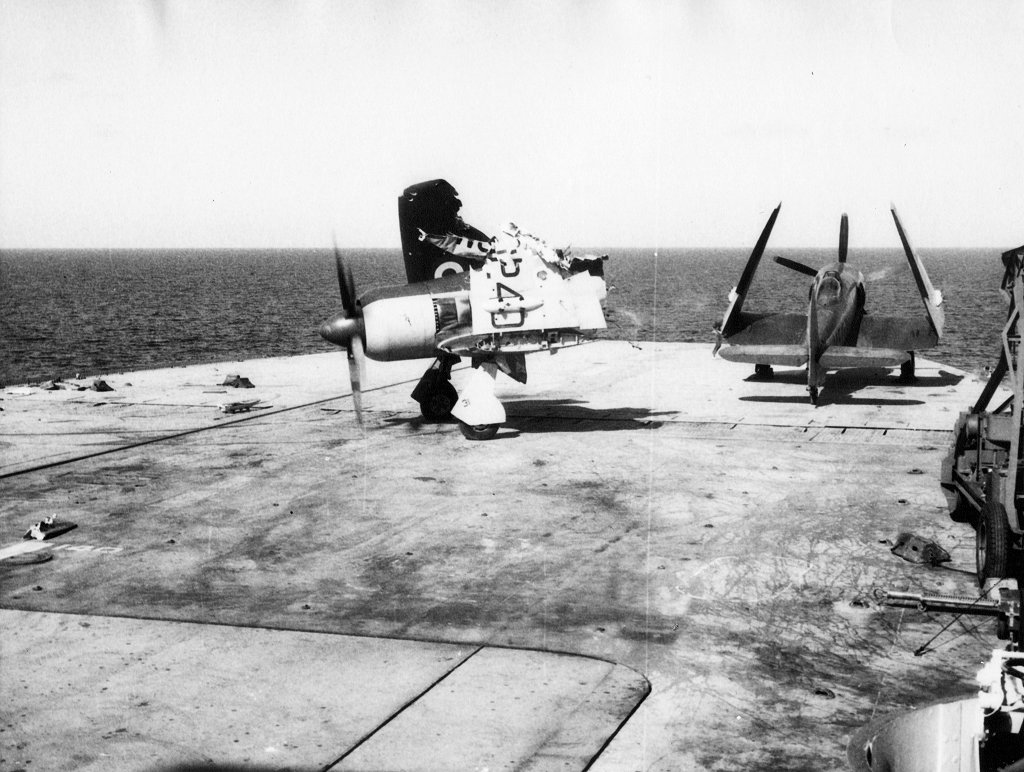
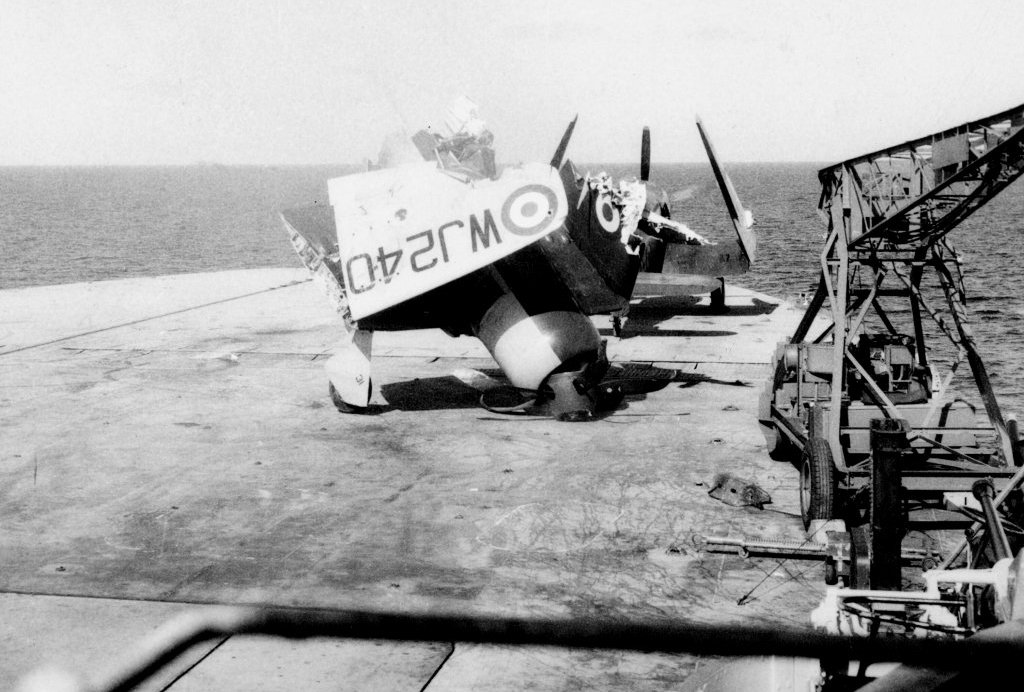

August 11th 1953, this sequence shows an 807-squadron incident on UNICORN: This is Sea Fury WJ240 piloted by Lt D. G. Halliday, he has landed and taxied forward beyond the barrier. Landing seconds later Sea Fury, WH623 piloted by Lt-Cdr J. W. Ayres has bounced and its hook engaged No. 2 barrier then stalled onto the deck striking WJ240 before going over the side in flames (not in shot). The impact causes Lt. Halliday to open the throttle wide and his aircraft begins an anti-clockwise circle around the deck. The tail section shears off and also vanishes overboard. Lt. Halliday applied the brakes, it then skidded on its nose towards the deck edge to collide with the Jumbo crane and catches fire. Lt. Halliday survived but was badly injured, Lt-Cdr Ayre was rescued unhurt by the ship's helicopter.
After a replenishment period the two carriers sailed for another, short patrol on the 24th to the 29th when they arrived at Kure. UNICORN sailed for Iwakuni on the 31st, after delivering 5 Sea Furies & 2 Fireflies on September 1st she embarked 1 Sea Fury from the AHU on the 4th and another from OCEAN on the 5th before sailing for Singapore.
UNICORN arrived at Singapore on September 21st. The following day she unloaded 8 Sea Furies 8 2 Fireflies for AHU Sembawang.
Return to the UK and transfer to the Reserve Fleet
UNICORN was released from operational duties on October 15th 1953, and she sailed from Singapore for home on 15 October 1953 and arrived at Devonport on 17 November, where she returned to reserve and was moored in the River Tamar. She was now redesignated as a ferry carrier and given the new pennant number A195. She remained manned by a reduced crew and capable of being reactivated for service until March 1957 when was reduced to, unmanned, extended reserve.
A modernisation refit had been considered many times to allow her to operate jet aircraft but was rejected as too costly; to meet the requirements her flight deck needed to strengthened, and reworked to incorporate an angled deck and a steam catapult. Her two hangars had insufficient height for the new aircraft types and consolidating them into one large hanger was considered but ultimately the huge cost killed the project. She remained in the reserve and placed on the disposal list in 1958. UNICORN was sold to Arnott Young Shipbreakers for scrap in June 1959 and towed to Dalmuir on the river Clyde, arriving on June 15th to begin the process. After stripping out at Dalmuir her hull was towed to Troon in 1960 to be broken up.

UNICORN at Dalmuir C.1959 for stripping out, thee first stage of her journey to be broken for scrap.
Foot note:
Commonwealth operations off Korea ended on May 4th 1954 when HMAS SYDNEY completed her tour: she was not relieved by another carrier. Before leaving Japan for Australia she embarked the aircraft held by the AHU at Iwakuni; her departure marked the end of the commonwealth participation in operations off Korea, and the end of the RN Aircraft Holding Unit at Iwakuni. The final stocks of aircraft were loaded in the second week of May 1954 and the RN AHU was withdrawn. SYDNEY off loaded 15 Firefly and 8 Sea Fury to RNAS Sembawang on the 18th – 20th May 1954.
« Part One: World War Two
Last modified: 23 February 2023
Primary information sources
Additional sources:
Landsdown. J.R.P, (1992) 'With the carriers in Korea - the Fleet Air Arm Story 1950 - 53' Worcester, Square One publications
Hobbs, D. (2007) 'Moving bases: Royal Navy Maintenance Carriers and MONABs' Liskeard, Maritime Books
Comments (0)